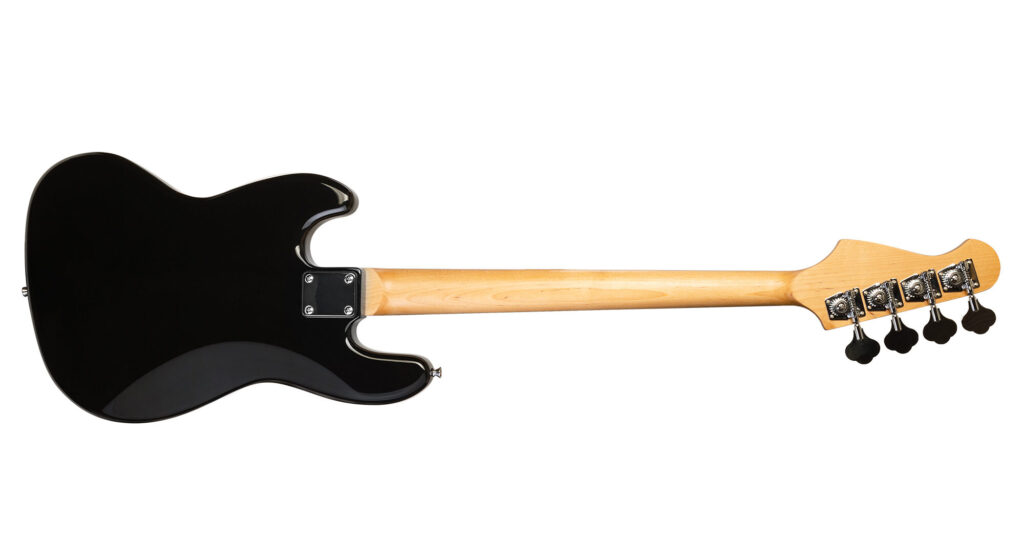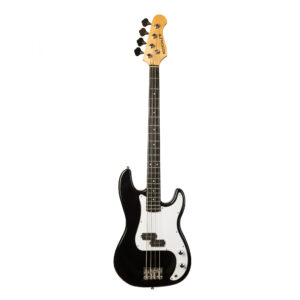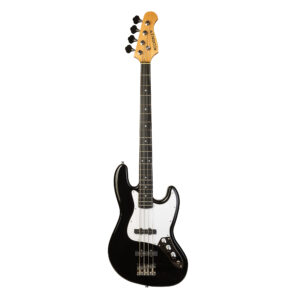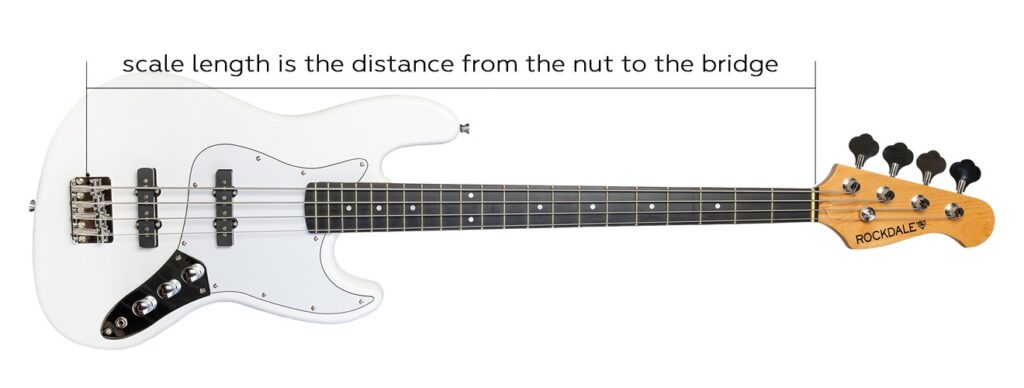Let's decide on the number of strings
A classical bass guitar has four strings. In most cases, this is sufficient to play any music and such a model is perfect for a beginner. However, in the hands of musicians, you can often see five- and six-string bass guitars. In fact, there are bass guitars with even more strings, but as a first instrument, they definitely will not suit you because of their extremely specific and narrow range of use and the difficulties in mastering the playing techniques.

Compared to the classic four-string, a bass with five strings provides additional possibilities in playing ultra-low notes. The fifth string expands the instrument’s range, adds variability in the choice of notes and fingerings. Six-string bass guitars, in addition to an additional low string, have one extra high string, expanding the possibilities for playing melodic passages. It might seem reasonable to take such an instrument – the more possibilities, the better! However, it’s not that simple: firstly, a five-string bass is significantly more expensive, and a six-string even more so. Moreover, finding a decent five- or six-string instrument for a small amount of money is almost like a fantasy, while there is a quite rich selection of worthy four-string bass guitars for a relatively reasonable amount.
Secondly, the set of strings for five and six-string guitars costs much more, and you will have to change the strings frequently.
Thirdly, the necks on such instruments are much wider and playing them is less comfortable.
Fourthly, many-string basses in the budget and mid-price segments (and hardly did you decide to immediately aim for a top and very expensive model for your first instrument) are often poorly balanced in terms of frequencies. Figuratively speaking, the fifth string is there, but it does not sound as good as the other four, or on the contrary, only it sounds decent.
The only reason, at this stage in life, not to avoid buying a five- or six-stringer is the desire to play a very specific kind of music, usually with a focus on very low bass. By the way, thanks to the use of lowered tunings, you can get sufficiently low notes even on four strings, read more about this, ask experienced friends, maybe this is your option.
In general, our recommendation is this: if you are a beginner and this is your first instrument, get a four-string. Only if you are sure that you cannot do without a fifth or sixth string, make your choice in their favor.

What you can temporarily ignore
One of the most popular questions from beginner bass guitarists is “Which brand of guitar should I get?” No major brand is inherently better or worse than another is; it only makes sense to compare specific models. The characteristic sound associated with a particular brand is usually in the top price range models (you hear them on recordings and at concerts). However, when it comes to the mid-to-low price ranges, where the introduction to the instrument usually begins, many manufacturers have learned to produce decent budget bass guitars. There are now a large number of manufacturers specializing in entry-level instruments, which, in terms of their characteristics, are no worse than the budget lines of top brands. Any serious Asian manufacturer can boast modern equipment, the ability to properly dry and process wood, professional specialists, and quality control systems. For this reason, it doesn’t make much sense to be overly concerned about the country of production. Thirty years ago, it was simple: America-Japan-South Korea, and so on, strictly in hierarchical order. Today, a high-quality affordable instrument can sound very decent, and the difference between guitars made in India, Venezuela, Indonesia, Vietnam, and so on, won’t be able to be explained as a strict trend, so you should only pay attention to the particular instrument.
What is the best wood for a bass-guitar?
Wood is another topic for debate. Different wood species do have slightly different sounds, but in budget lines, this doesn’t play any role at all. The thing is, apart from wood, there are much more important components, against which the value of wood in shaping the final sound is not that significant. Secondly, if there were universal standards for the sound of wood species, the world would be much clearer. In practice, within the same wood species, there are many varieties, plus the importance of the tree’s habitat, its age, place of cutting, type of sawing, drying conditions, painting, etc. Bodies can be made from a single piece of wood, or from several different ones. As a result, nominally two guitars made from the same wood species will sound completely different. This also applies to the wood from which the neck and fingerboard are made. We highly recommend not even trying to base your choice on wood. In 100% of cases, your bass will sound good (or bad) not for this reason.
Option for neck attachment: bolts or through-body
The neck, attached to the body with bolts, or the neck that goes through the body, is another favorite subject of debate. Theoretically, it is considered that a bolt-on neck provides a brighter attack and better clarity, while neck-through-body design – better sustain (the duration of a note’s sound), vocal quality, and richer, beautiful overtones. Again, these are already minor nuances, that are not so important at the initial stage, and there are more than enough exceptions to this rule. By the way, a guitar with a neck-through design will cost significantly more. Whether you need to overpay is up to you. We think that it’s not necessary at this stage.

The neck attached to the body with bolts
What to pay attention to
The shape of the instrument’s body is extremely important. Apart from the external appearance and overall aesthetics, it determines the comfort of the instrument for the specific musician. We recommend trying out guitars with different shapes in a music store to understand which one is more comfortable for you.


The quality of manufacture is perhaps the most important aspect to pay attention to. When choosing a guitar, run your hand along both sides of the neck. The fret ends should be well polished and not scratch your fingers. Then, hold the guitar as if it were a rifle you are aiming, and in this position, you’ll be able to see if the guitar has any neck warping. A slight bend in the middle is normal, but if the neck has warping in other planes, you should not purchase such a guitar. Pay attention to the string height over the neck; if the strings are set too high, playing the instrument will be uncomfortable. This could be due to improper adjustment of the string height, and it might be possible to lower the strings without issues. However, it’s very likely that the strings are set high because lowering them further would cause them to buzz against the frets and produce unpleasant buzzing or even completely block the sound of individual notes. This can happen due to defects in the fretboard or the frets protruding from it. This is visually difficult to determine. Ask a store employee to lower the strings and play each note on each string in each position attentively. If there is buzzing, it’s not advisable to buy such an instrument.
Plug the guitar into an amplifier and listen to the sound – this is the most important aspect of the instrument! Besides checking the sound quality, it’s also important to do the following: at sufficient amplifier volume, listen for any background noise, hum, or strange sounds in the guitar’s sound. Try turning the volume and tone knobs – if there’s any unpleasant crackling or static from the amplifier, all these signs indicate problems with the electronics and shielding of the guitar. Technician can fix these things or make modification – but is that something you want to spend time on? Examine the quality of the paint and lacquer application. Typically, it can say a lot about the overall quality of the instrument. If you see runs in the lacquer, uneven coloring, and so on, it’s likely that you’re looking at an instrument of questionable quality that you should avoid.
Scale length selection
The scale length is the distance from the point where the string rests on the bridge to the point where it rests on the nut. Regarding this parameter, we highly recommend approaching this issue exclusively from the perspective of performance comfort and finger positioning on the fretboard, while temporarily setting aside considerations regarding the impact of scale length on sound and string tension. The classic scale length is 34″, and you will see it in 90% of bass guitars. If for some reason you find it uncomfortable to play on such a guitar, you can try looking for an instrument with a reduced scale length or a multi-scale one.

Pickups
For a more aggressive sound with powerful bass, “humbucker” type pickups are recommended, while for a more balanced and mellow sound, “single-coil” pickups may be preferred. However, in the bass guitar world, there isn’t as significant a difference between these two types of pickups as there is in the guitar world. You can perfectly play metal on a Jazz Bass-style guitar with single-coils and soft jazz on a bass with active powerful humbuckers. It’s largely a matter of personal taste. Therefore, the main advice here is to listen with your own ears and choose according to your preference.

Jazz Bass-style pickups (single-coil)

Precision Bass-style pickups (humbuckers)
Where to buy your first bass guitar?
When choosing your first, likely not very expensive, instrument, it is crucial to have the opportunity to listen to it before buying, check its quality of construction, and most importantly, compare it with others. Even after reading numerous articles and watching countless videos online, you won’t be able to definitively determine your instrument without visiting a music store, listening, and comparing many different bass guitars.
A large music store is great because it allows you to listen to many different bass guitars on the same amplifier and with the same settings, making the differences between them more evident.
The secondary market for guitars is quite developed, but in our view, it’s better to buy your first guitar in a music store. Firstly, without experience, it’s unlikely you can accurately evaluate the actual condition of the offered bass by yourself. Secondly, you won’t have anything to compare the sound of this particular model with, and as we mentioned, it’s crucial to have the opportunity to compare it with others to understand the pros and cons based on your experience. Thirdly, the price difference between budget guitars in the secondary market and those in a store is much lower than that of premium instruments, so your saving will be much less than the missed opportunities that visiting a store will provide.
Good luck in choosing your first bass guitar. Go for it and rock the world, it’s all in your hands!